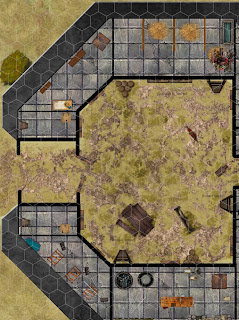Playing with folks from all over the interwebs or old friends in different states, with all the tools, from dice rolling and minis and maps, make the VTT a great 21 century tool for Role Playing across the void of time and space (okay, that was a bit more dramatic that what I was actually going for but you get the idea).
Over the years I've browsed through Fantasy Grounds, Open RPG and a couple of others (you can see a full list here). But what I found with these is a large learning-curve, cost for the application (usually for the GM), or platform specific (yeah, I'm on a Mac). I had no intention of making my job as GM more complicated than it already was.
Then I came across Roll 20 a while back. Roll 20 is a browser-based VTT, that is both non-browser and non-platform specific, has a much smaller learning-curve, and a responsive development team. And one other thing is that it's free to use.
You can go through your own research, walk-throughs and toying around with Roll20 if you haven't already. I think you'll find it pretty robust. What I really want to talk about is my experiences in preparing and running a Roll 20 game with an old school perspective.
Preparing the Session Part 1
As most of you know, as a GM, there is plenty to gather and organize for any gaming session. A session in a VTT where you want to take full advantage of the application's tools is a whole additional process.
There are many different ways to play a session on the VTT. One is to just use the app for the group dice rolling, the other is to just import a scan of the map and reveal it as the players explore. Another way is to build the scaled detailed map using the mapping tiles and populate the map with all manner of dungeon dressings available. I choose to go with the later and experiment with the full process of the Virtual Environment created by the VTT.
Modern gaming usually has a smallish 'battle-map' that leads to the big-boss fight. The scale of these 'adventures' is pretty small compared to mega-dungeon or free-form sandbox of old style of play. And, of course, I was going for the later with a multi-level smallish megadungeon.
 |
| One of 2 Upper Level maps created. |
In Roll20 you have all the tools in game to create a map or maps ahead of time and so I set out building my dungeon. I decided to run my Outpost on the Edge of the Far Reaches adventure module and began translating that into the Roll20 table-top environment. I began building the map directly in the application, which is fine for smaller encounter based adventure but for megadungeons can pose a bit of a problem with the number of images that has to be generated by the online application. All the individual floor tiles, props and monsters all take time to render and can potentially slow the game down. I later found that it is better to create your maps in an outside application such as Photoshop or GIMP.
Now, it does take a while to create one of these maps and I'm looking at created four or more of them in the VTT style. But I chugged away at it and I eventually finished and imported the maps into the campaign.
My main concern was that in traditional table-top play - old school style, battle maps and minis rarely came into play. The game mostly rides on the imagination of each player. I began to wonder if these overly detailed maps might take away from the game being played in the mind to the game being played on screen. I couldn't predict how that would go but I was surprised at how the players interacted with the detailed map.
 |
| One of 4 lower level maps created. |
Roll 20 supports a fog of war feature that lets you reveal map areas to the players as you see fit. They also support a Dynamic Lighting feature (for paying users) that let you 'program' how a torch light would interact with the environment. Again, that would add another level of prep time for the GM and all within the VTT itself. Since I'm playing with the free version, the fog of war is all I have to play with and that's plenty.
With the maps created, I moved on to populating my virtual dungeon and I'll cover that tomorrow in part two.
Part 3 can be found here.
